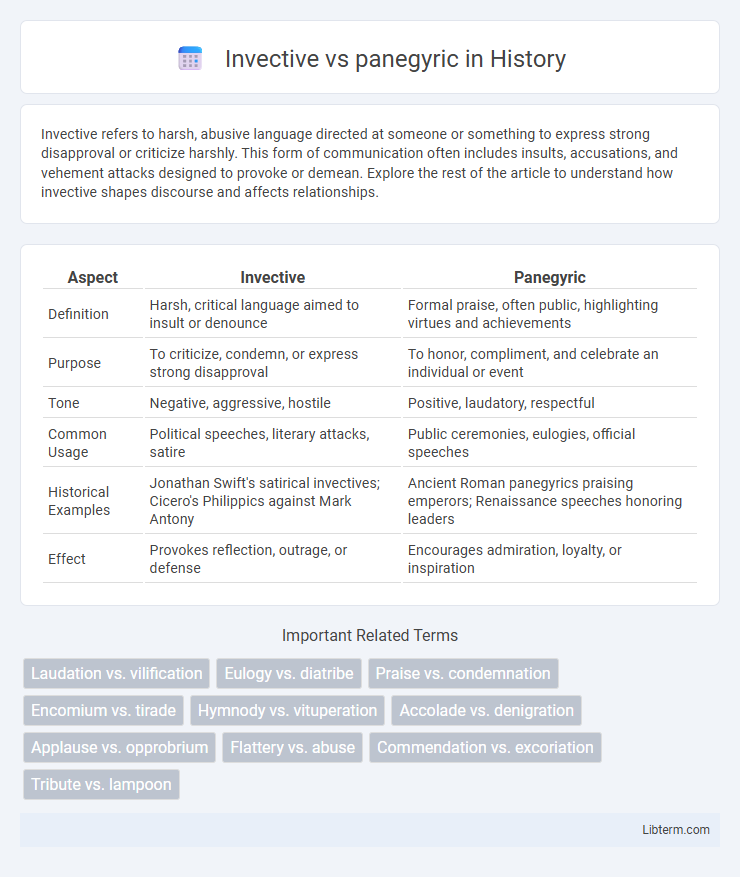Invective refers to harsh, abusive language directed at someone or something to express strong disapproval or criticize harshly. This form of communication often includes insults, accusations, and vehement attacks designed to provoke or demean. Explore the rest of the article to understand how invective shapes discourse and affects relationships.
Table of Comparison
| Aspect | Invective | Panegyric |
|---|---|---|
| Definition | Harsh, critical language aimed to insult or denounce | Formal praise, often public, highlighting virtues and achievements |
| Purpose | To criticize, condemn, or express strong disapproval | To honor, compliment, and celebrate an individual or event |
| Tone | Negative, aggressive, hostile | Positive, laudatory, respectful |
| Common Usage | Political speeches, literary attacks, satire | Public ceremonies, eulogies, official speeches |
| Historical Examples | Jonathan Swift's satirical invectives; Cicero's Philippics against Mark Antony | Ancient Roman panegyrics praising emperors; Renaissance speeches honoring leaders |
| Effect | Provokes reflection, outrage, or defense | Encourages admiration, loyalty, or inspiration |
Defining Invective and Panegyric
Invective is a form of expression characterized by harsh, abusive, and critical language aimed at denouncing or attacking a person, group, or idea. Panegyric, in contrast, is a formal speech or written text that praises and glorifies someone or something, often highlighting virtues and achievements. Both serve distinct rhetorical purposes: invective condemns, while panegyric celebrates.
Historical Origins of Invective and Panegyric
Invective traces its roots to ancient Rome, where orators like Cicero employed harsh language to criticize political opponents, shaping early rhetorical traditions of public denunciation. Panegyric originated in classical Greek and Roman cultures as formal speeches or writings crafted to praise and celebrate individuals, often leaders or deities, reinforcing social hierarchies and virtues. Both forms evolved within the context of public discourse, serving contrasting purposes of condemnation and exaltation in historical rhetoric.
Core Characteristics of Invective
Invective is characterized by its aggressive, harsh language aimed at insulting or denouncing a person or idea through blame, curses, or abusive criticism. It often uses vivid, emotionally charged words to provoke anger or contempt, emphasizing negativity and condemnation. Unlike panegyric, which praises and elevates its subject, invective aggressively dismantles its target's reputation or character.
Essential Traits of Panegyric
Panegyric is a formal public speech or written text that delivers high praise, emphasizing the virtues, achievements, and honorable qualities of an individual or subject. It typically employs elevated language, positive tone, and structured rhetoric to inspire admiration and reinforce social values. Unlike invective, which is characterized by bitter criticism and insults, panegyric aims to celebrate and honor its target through commendation and laudatory expression.
Invective in Literature and Rhetoric
Invective in literature and rhetoric refers to a harsh, abusive language aimed at criticizing or condemning a person, idea, or institution. It is characterized by emotional intensity and vivid imagery designed to provoke a strong negative reaction from the audience. Commonly used in satirical works and political speeches, invective serves as a powerful tool for social criticism and moral condemnation.
Panegyric in Classical and Modern Contexts
Panegyric, a formal public speech or written text that delivers high praise, originated in Classical antiquity as a rhetorical form used to honor gods, emperors, or military leaders, emphasizing virtues such as bravery and wisdom. In the contemporary context, panegyric has evolved beyond its ceremonial roots to include diverse media formats, from political speeches to literary tributes, maintaining its core purpose of extolling achievements with persuasive and emotive language. Modern panegyrics often reflect cultural values and societal ideals, adapting classical principles to celebrate figures and ideas in ways that influence public perception and historical legacy.
Purposes and Effects of Invective
Invective serves the purpose of expressing strong criticism or condemnation, often targeting individuals or ideas to provoke emotional reactions such as anger, shame, or defensiveness. Its effect is to undermine the subject's credibility and morality, creating a sense of hostility or urgency that compels the audience to reject or oppose the target. This rhetorical device intensifies negative perceptions and polarizes opinions by employing harsh language and vivid imagery.
Functions and Influence of Panegyric
Panegyric serves to celebrate and extol the virtues and achievements of an individual or entity, often reinforcing social values and ideals. Its function is to inspire admiration, reinforce group identity, and legitimize authority through eloquent praise. Panegyrics influence cultural and political narratives by shaping public perception and enhancing the reputation of their subjects.
Comparing Uses in Political Discourse
Invective and panegyric serve contrasting functions in political discourse, with invective aimed at vehemently criticizing opponents through harsh language and panegyric used to deliver laudatory praise that elevates a politician's achievements and character. Invective often mobilizes public sentiment by highlighting faults and failures, thereby undermining political adversaries, while panegyric seeks to build authority and inspire support by emphasizing virtues and successes. Both rhetorical strategies play strategic roles in shaping political narratives, influencing public opinion, and consolidating power.
The Impact of Invective and Panegyric on Audience Reception
Invective employs sharp, critical language that intensifies negative emotions, often provoking defensive or hostile reactions from the audience. Panegyric, through its laudatory and positive tone, fosters admiration and strengthens emotional bonds with the subject, leading to increased audience engagement and support. The contrast in tone between invective and panegyric significantly shapes audience reception by either polarizing opinions or uniting listeners through shared praise.
Invective Infographic

 libterm.com
libterm.com